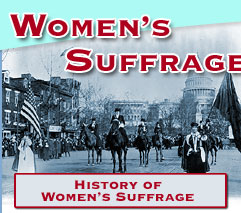women's suffrage.
Women's Suffrage
Women's Suffrage, the right of women to vote in political elections (long called woman suffrage) represents the first stage in the demand for political equality.
American women were the first in the world to voice organized demands for the vote. Abolitionist activists Lucretia Mott and Elizabeth Cady Stanton, along with several other women friends, convened a meeting in Stanton's hometown of Seneca Falls, N.Y., "to discuss the social, civil, and religious condition and rights of women." At the convention, held on July 19–20, 1848, Stanton read her "Declaration of Sentiments and Resolutions," and the convention debated and approved a series of resolutions designed to win equality for women.
The Republican party passed the 14th and 15th amendments to the U.S. Constitution, which gave the vote to black men but not to women. As a result suffragists split into two rival factions. Stanton and Susan B. Anthony, her longtime colleague, refused to support the 15th Amendment because it did not enfranchise women, favoring passage of another constitutional amendment to do so. They formed the National Woman's Suffrage Association (NWSA) in 1869. Conservative feminists, led by Lucy Stone; her husband, Henry Blackwell; and Julia Ward Howe, supported the 15th Amendment and campaigned for the passage of state laws to enfranchise women. They established the American Woman's Suffrage Association (AWSA) in 1869. The AWSA and NWSA eventually reconciled and in 1890 merged to become the National American Woman Suffrage Association (NAWSA). Anthony retired from the presidency of NAWSA in 1900. Carrie Chapman Catt, who succeeded her, organized both a well-coordinated state-by-state and a national effort. By 1910 women had the right to vote in Wyoming, Utah, Idaho, Colorado, and Washington.
In 1916 Alice Paul and other activists, left the NAWSA to form the National Woman's Party. To bring pressure on Pres. Woodrow Wilson to back congressional passage of a constitutional amendment, they picketed the White House and chained themselves to the White House fence. Grateful to American women for their active participation during World War I (1917–1918), Congress passed a woman suffrage constitutional amendment in 1919. It was approved by the states in August 1920.
Remembering Suffrage
Clip 1
If you are having diffulty playing these clips please click here to download Real Player.
Thought Questions:
Why do you think voting is important?
Who do you think has the right to vote and why?
As you fill in your KWL chart ask yourself: "What do I know about voting rights for women and what do I want to know ?
Don't forget to add the new information you learn to "L" part of the KWL Chart, so you can contribute to the discussion as we update our class KWL chart each session.


